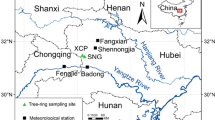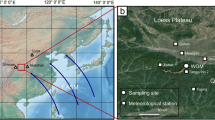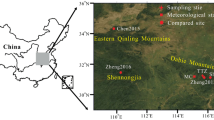Abstract
Phenological data obtained from historical documents constitute highly important ecological evidence for the pre-instrumental period, and can be used in analyzing climatic change in history. In this study, 87 phenological records about seasonality of non-biological events (e.g., first frost date), agriculture and ornamental plants (e.g., first flowering date) over 77 years were extracted from historical documents from the Sui and Tang dynasties in China to reconstruct the winter half-year (from October to next April) temperatures in the Guanzhong Area (located in central China) from 600 to 902 AD. Transfer functions between temperature and phenophases with significant correlations were established by using modern observation data. Temperatures from the study period were reconstructed by applying the transfer functions to historical phenological data. The reconstruction indicates that the winter half-year temperatures during 600–902 AD were 0.23°C higher than the reference period (1961–1990). The temperature changed with two distinct stages. During the 600s–800s, temperatures were approximately 0.38°C higher than at present but then temperatures decreased in the subsequent period (800–902 AD). These results are similar to ones from previous studies on the mean temperature and the divisions between warm and cold periods during the study period, though differences were found in the degree of warmness/coldness. This reconstruction provides a valuable contribution to a better understanding of climatic variability during the Sui and Tang dynasties in China.
Similar content being viewed by others
References
Ahmed M, Anchukaitis K J, Asrat A, Borgaonkar H P, Braida M, Buckley B M, Buntgen U, Chase B M, Christie D A, Cook E R, Curran M A J, Diaz H F, Esper J, Fan Z X, Gaire N P, Ge Q S, Gergis J, Gonzalez- Rouco J F, Goosse H, Grab S W, Graham N, Graham R, Grosjean M, Hanhijarvi S T, Kaufman D S, Kiefer T, Kimura K, Korhola A A, Krusic P J, Lara A, Lezine A M, Ljungqvist F C, Lorrey A M, Luterbacher J, Masson-Delmotte V, McCarroll D, McConnell J R, McKay N P, Morales M S, Moy A D, Mulvaney R, Mundo I A, Nakatsuka T, Nash D J, Neukom R, Nicholson S E, Oerter H, Palmer J G, Phipps S J, Prieto M R, Rivera A, Sano M, Severi M, Shanahan T M, Shao X M, Shi F, Sigl M, Smerdon J E, Solomina O N, Steig E J, Stenni B, Thamban M, Trouet V, Turney C S M, Umer M, van Ommen T, Verschuren D, Viau A E, Villalba R, Vinther B M, von Gunten L, Wagner S, Wahl E R, Wanner H, Werner J P, White J W C, Yasue K, Zorita E. 2013. Continental-scale temperature variability during the past two millennia. Nat Geosci, 6: 339–346
Aono Y, Kazui K. 2008. Phenological data series of cherry tree flowering in Kyoto, Japan, and its application to reconstruction of springtime temperatures since the 9th century. Int J Climatol, 28: 905–914
Aono Y, Saito S. 2010. Clarifying springtime temperature reconstructions of the medieval period by gap-filling the cherry blossom phenological data series at Kyoto, Japan. Int J Biometeorol, 54: 211–219
Badeck F W, Bondeau A, Böttcher K, Doktor D, Lucht W, Schaber J, Sitch S. 2004. Responses of spring phenology to climate change. New Phytol, 162: 295–309
Chuine I, Yiou P, Viovy N, Seguin B, Daux V, Ladurie E L. 2004. Historical phenology: Grape ripening as a past climate indicator. Nature, 432: 289–290
Dai J H, Wang H J, Ge Q S. 2013. Multiple phenological responses to climate change among 42 plant species in Xi’an, China. Int J Biometeorol, 57: 749–758
Etien N, Daux V, Masson-Delmotte V, Stievenard M, Bernard V, Durost S, Guillemin M T, Mestre O, Pierre M. 2008. A bi-proxy reconstruction of Fontainebleau (France) growing season temperature from 1596 to 2000 AD. Climate of the Past, 4: 91–106
Fang X Q, Xiao L B, Ge Q S. 2005. Changes of plants phenophases and temperature in spring during 1888–1916 around Changsha and Hengyang in Hunan Province (in Chinese). Quat Sci, 25: 74–79
Ge Q S, Liu H L, Zheng J Y, Zhang X Z. 2010. Reconstructing temperature change in Central East China during 601–920 AD. Chin Sci Bull, 55: 3944–3949
Ge Q S, Wang H J, Zheng J Y, Rutishauser T, Dai J H. 2014. A 170 year spring phenology index of plants in eastern China. J Geophys Res, 119: 301–311
Ge Q S, Zheng J Y, Fang X Q, Man Z M, Zhang X Q, Zhang P Y, Wang W C. 2003. Winter half-year temperature reconstruction for the middle and lower reaches of the Yellow River and Yangtze River, China, during the past 2000 years. Holocene, 13: 933–940
Ge Q S, Zhang P Y. 1990. The evaluation on climatic information in the historical literatures (in Chinese). J Geogr Sci, 45: 22–30
Gong G F. 1983. Historical Periods of Climate Change Research Methods (in Chinese). Beijing: Science Press. 53
Gong G F, Zhang P Y, Zhang J R. 1984. The variation of phenodate in Beijing district. Chin Sci Bull, 29, doi: 10.1360/sb1984-29-12-1650
Hao Z X, Ge Q S, Zheng J Y. 2009. Temperature variations during the Song and Yuan dynasties (960–1368 AD) in the eastern part of North West China (in Chinese). Quat Sci, 29: 871–879
Houghton J T, Ding Y H, Griggs D J, Noguer M, van der Linden P J, Dai X, Maskell K, Johnson C A. 2001. IPCC, 2001: Climate Change 2001: The Scientific Basis. Contribution of Working Group I to the Third Assessment Report of the Intergovernmental Panel on Climate Change. Cambridge: Cambridge University Press. 156
Kiss A, Wilson R, Bariska I. 2011. An experimental 392-year documentary- based multi-proxy (vine and grain) reconstruction of May-July temperatures for Koszeg, West-Hungary. Int J Biometeorol, 55: 595–611
Lan Y. 2001. Climatic variations and the rise and fall of the Tang dynasty (in Chinese). Collections of Essays on Chinese Historical Geography, 16: 4–15
Liu B T, Man Z M. 2012. A study on climate of cold and warm in 1609–1616 AD in Wei Shuixuan Diary in the lower reaches of Yangtze River (in Chinese). J Chin Hist Geogr, 27: 16–22
Liu Y C, Wang H J, Dai J H, Li T S, Wang H L, Tao Z X. 2014. The application of phonological methods in reconstruction of past climate changes (in Chinese). Geogr Res, 33: 2–15
Man Z M. 1998. Climate in Tang Dynasty of China: Discussion for its Evidence (in Chinese). Quat Sci, 1: 20–30
Meier N, Pfister C, Wanner H, Rutishauser T, Pfister C, Wanner H, Luterbacher J. 2007. Grape harvest dates as a proxy for Swiss April to August temperature reconstructions back to 1480 AD. Geophys Res Lett, 34: 22–28
Možný M, Brázdil R, Dobrovolný P, Trnka M. 2012. Cereal harvest dates in the Czech Republic between 1501 and 2008 as a proxy for March- June temperature reconstruction. Clim Change, 110: 801–821
Pfister C, Luterbacher J, Wanner H, Wheeler D, Brázdil R, Ge Q S, Hao Z X, Moberg A, Grab S, del Prieto M R. 2008. Documentary evidence as climate proxies. Proxy-specific White Paper produced from the PAGES/CLIVAR workshop, Trieste: 1–5
Qian L Q. 1991. Climate of Loss Plateau (in Chinese). Beijing: China Meteorological Press. 54
Root T L, Price J T, Hall K R, Schneider S H, Rosenzweig C, Pounds J A. 2003. Fingerprints of global warming on wild animals and plants. Nature, 421: 57–60
Schwartz M D. 2003. Phenology: An Integrative Environmental Science. Dordrecht: Kluwer Academic Publishers. 2
Sparks T H, Jeffree E P, Jeffree C E. 2000. An examination of the relationship between flowering times and temperature at the national scale using long-term phenological records from the UK. Int J Biometeorol, 44: 82–87
Wan M W, Liu X Z. 1979. Phenological Observation Methods in China (in Chinese). Beijing: Science Press. 18
Wu H Q, Dang A R. 1998. Fluctuation and characteristics of climate change in temperature of Sui-Tang times in China (in Chinese). Quat Sci, 2: 31–38
Yang B, Braeuning A, Johnson K R, Shi Y F. 2002. General characteristics of temperature variation in China during the last two millennia. Geophys Res Lett, 29: 38–42
Zhang F C. 1999. China’s flower calendar and reconstruction of climate in 6th century in China (in Chinese). Geogr Res, 18: 143–147
Zhang X X, Ge Q S, Zheng J Y, Zhang F C. 2005. Responses of spring phenology to climate changes in Beijing in last 150 years (in Chinese). Chin J Agrometeorol, 26: 263–267
Zheng J Y, Ge Q S, Hao Z X, Zhong S Y, Ma X, Zhang X Z. 2012. Changes of spring phenodate in Yangtze River Delta Region in the past 150 years (in Chinese). J Geogr Sci, 67: 45–52
Zheng J Y, Man Z M, Fang X Q, Ge Q S. 2005. Temperature variation in the eastern China during Wei, Jin and South-North Dynasties (220–580 AD) (in Chinese). Quat Sci, 25: 129–140
Zhu K Z. 1973. A preliminary study on the climate changes since the last 5000 years in China (in Chinese). Sci China, 2: 15–38
Zhu S G, Wang Y L, Hu L G. 1998. Study on climate variations in the region of Guanzhong in the historical period (in Chinese). Quat Sci, 2: 1–11
Author information
Authors and Affiliations
Corresponding author
Rights and permissions
About this article
Cite this article
Liu, Y., Dai, J., Wang, H. et al. Phenological records in Guanzhong Area in central China between 600 and 902 AD as proxy for winter half-year temperature reconstruction. Sci. China Earth Sci. 59, 1847–1853 (2016). https://doi.org/10.1007/s11430-016-5325-5
Received:
Accepted:
Published:
Issue Date:
DOI: https://doi.org/10.1007/s11430-016-5325-5




